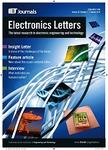版权所有:内蒙古大学图书馆 技术提供:维普资讯• 智图
内蒙古自治区呼和浩特市赛罕区大学西街235号 邮编: 010021

作者机构:Sun Yat Sen Univ Sch Elect & Informat Technol Guangzhou 510006 Guangdong Peoples R China
出 版 物:《ELECTRONICS LETTERS》 (电子学快报)
年 卷 期:2021年第57卷第17期
页 面:653-655页
核心收录:
学科分类:0808[工学-电气工程] 0809[工学-电子科学与技术(可授工学、理学学位)] 08[工学]
基 金:Science and Technology Program of Guangdong Province [2019B010140002]
主 题:Optical, image and video signal processing Image sensors Computer vision and image processing techniques Data handling techniques Neural nets
摘 要:RGB-Infrared person re-identification (RGB-IR Re-ID) is a task aiming to retrieve and match person images between RGB images and IR images. Since most surveillance cameras capture RGB images during the day and IR images at night, RGB-IR Re-ID is helpful when checking day and night surveillance for criminal investigations. Previous related work often only extracts sharable and identity-related features in images for identification. Few researches specifically extract and make use of features that do not have the ability to distinguish identity, e.g. identity-unrelated features derived from background and modality. In this Letter, we propose a novel and concise RGB-IR Re-ID network named two-way constraint network (TWCN). Compared with traditional Re-ID networks, TWCN not only extracts and utilises identity-related features but also novelly makes full use of identity-unrelated features to improve the accuracy of the experiment. TWCN uses a reverse-triplet loss to extract identity-unrelated features, and proposes an orthogonal constraint to remove identity-unrelated information from identity-related features, which improves the purity of identity-related features. In addition, a correlation coefficient synergy and central clustering (CCSCC) loss is introduced into TWCN to extract identity-related features effectively. Extensive experiments have been conducted to prove our method is effective.